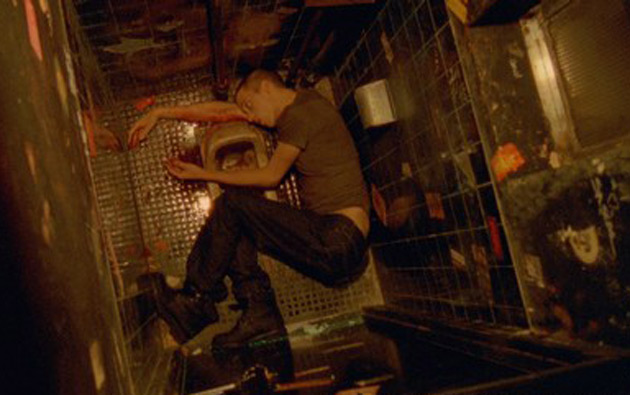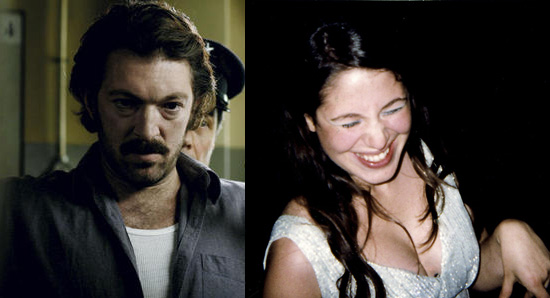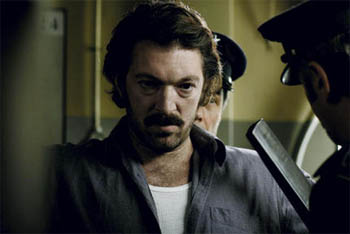The Void, in Gaspar Noe’s third feature film, is a Tokyo nightclub. This being a Gapar Noe film, the Void is somewhat dicey. It isn’t nearly as bad as the Rectum, that sleazy nightclub with the annoying audio pulse and the vengeful men running in with the fire extinguisher, which appeared at the beginning (the end!) of Irreversible, or even another strip club down the street from the Void. But this does leave one to naturally wonder if Noe’s second film was originally titled Enter the Rectum.
Does Noe considers his audience to be on the receiving end of a two hour sodomizing session? I’m happy to report that I didn’t feel sodomized by Enter the Void – in large part because I think I’ve caught onto what Noe’s trying to do. He presents himself as a provocateur, but he’s really more interested in chronicling an entirely ridiculous human experience on film – masked by the “intensity” of ten minute rape scenes, creepy incest, crude drug addiction, and the like – and seeing if the audience will accept it. This makes Gaspar Noe more of a carnival barker (and personally I have no problem with this) than a bona-fide behavioral chronicler, although I suspect Noe, like any desperate man who thinks he is a revolutionary, would argue that he is serious. (This may also explain why his three feature films have become progressively less “real” and more centered around some outre cinematographic approach. In the case of Enter the Void, the film starts from the perspective of Oscar, a drug dealer tripping the not so fantastic in his Tokyo apartment. And when I say it is from his perspective, the film is literally what he sees through his eyes – a technique that hasn’t been attempted at length since Robert Montgomery’s Lady in the Lake.)
Because most audience members are likely to be shocked (four critics walked out of the press screening I attended: they clearly didn’t know what they were missing!), Noe wins the “game” by default. And for those who hate his movies, the ones who stick around out of obligation or because they don’t want Noe to win, Noe still wins because this audience doesn’t get it.
And then there’s the rest of us: the ones who accept Noe’s films, finding varying degrees of admiration (this funny Frenchman certainly isn’t devoid of talent), but who eventually grow out of them. The last time Noe tried to tie me up in one of his artistic dungeons, I was in my twenties and thus more impressionable. It was a badge of honor to sit through a Gaspar Noe film to the bitter end and find a way to appreciate it. And even though I still admire Irreversible (and, for that matter, I Stand Alone), I don’t think that Noe’s films are going to hold up very well. Before Enter the Void (and in tandem with my recent interview with Vincent Cassel), I decided to watch Irreversible for the first time in eight years. While I still appreciated Noe’s narrative technique (a scene unfolds, and is subsequently followed up with another scene before it), the handheld camera and the long takes (to say nothing of the homophobia) made the movie feel very much like a bad trip-hop band or an angry zine editor from the 1990s who didn’t realize he was repeating an endless cycle: it was something forgotten for a very good reason.
Noe’s approach is very similar to the behavior of an online troll. And it’s too bad that Noe feels the need to cloak his films like this. Because it will cause otherwise astute yet easily offended filmgoers from appreciating his visual innovations and his creative audacity. Here is a man who is willing to include a shot of a vagina, taken from the inside, with the cock sliding in and out. It’s a silly and brazen image, one that recalls the many giant penises throbbing within Ken Russell’s greatly underrated Lisztomania. But no real cultural appreciator can discount a filmmaker who has the balls (so to speak) to risk ridicule like this. (Childish, you say? Lowbrow? Obscene? Well, what makes Noe’s cock any worse than the asshole kissing in “The Miller’s Tale?” Which is not to suggest that Noe should be compared with Chaucer. I don’t want to feed the man’s ego if he’s reading this. But propriety is too delimiting a value with which to assess or experience art.)
So it’s frustrating that Gaspar Noe has given us his best film with Enter the Void, styling it with so many reckless yet incredible ideas (a drug experience captured from first-person; an effort to depict the experience of dying from several camera angles; the camera transcending voyeurism and actually entering a character’s head while fucking; a stripper dancing around a pole from a top angle, with the camera capturing the crude leers of the audience; an overview of Tokyo with cardboard cars and buildings rendered flat; the hilariously inappropriate end credits not appearing at the end, causing uncomfortable audience members to flee the theater before their thoughts are read by others – to name but a few), while lacking the courage to be an adult. Certainly the best way to appreciate a Gaspar Noe film is to accept Gaspar Noe as Gaspar Noe. And the film’s first hour is the most focused work that Noe has done as a filmmaker. It is steeped in isolation and loss, with an older figure, just as dissolute, approaching the young DMT-craving Oscar with new ideas on how to live (and giving him The Book of the Dead). This is all primitive philosophy, to be sure (as is the cosmic camera featured throughout the film, shuttling between live and dead characters; one is viscerally struck by the idea of stray souls conveyed as radio signals, yet when one stops to think about the idea…). As a filmmaker, Noe has never been what one might call a deep thinker. But I appreciated the way that Noe made an attempt to offer a crude framework for his shopworn street material. (And I would argue that Noe’s reliance upon silly character developments and his view of his own characters as mere playthings is his primary weakness, the very quality that prevents him from being one of our greatest filmmakers.) The film sustains this tone for quite a while before Noe the Adolescent returns yet again, playing the incest card in an utterly camp way. (“Do you remember that promise we made?” might almost be viewed as a postmodern line conveying the covenant between audience and filmmaker. There’s one moment midway through the film where “Gaspar” is named as the guy entering a character into a seedy locale. At least this time around, Noe is more transparent about the “game” at work here, which is also mirrored by a prominent portion of the film photographed solely from the back of a character’s head.)
No doubt Noe would accuse me of succumbing to petite-bourgoisie values in my older age for expecting more out of him or for hoping for artistic evolution beyond the visual. (I would reply by showing him by extremely shaky bank statement and my punkass book collection.) But while Enter the Void is very much a movie that I can recommend to a cineaste who doesn’t have a stick up his ass (and one that I will probably see again), I’m wondering if Gaspar Noe even has a persuasive fourth feature film in him, or even a movie that can stand toe-to-toe with someone like Bunuel or Pasolini, both of whom were more genuinely interested in perverse human behavior. You’d think that a man in his mid-forties would have worked out most of his adolescent expressive fixations by now. While the film world certainly needs a guy like Noe, maybe this is all Gaspar Noe has to give the film world.


 Correspodnent: Does movement offer a more creative place to establish a character? More so than the backstory, research, or anything?
Correspodnent: Does movement offer a more creative place to establish a character? More so than the backstory, research, or anything? Correspondent: You note of [your future husband] Ben that, as you watched him calmly rub soap into his hands by the communal sink, you realized that you had known all along that you would see him again. I’m wondering what it is about hand hygiene that serves as your personal madeleine.
Correspondent: You note of [your future husband] Ben that, as you watched him calmly rub soap into his hands by the communal sink, you realized that you had known all along that you would see him again. I’m wondering what it is about hand hygiene that serves as your personal madeleine.